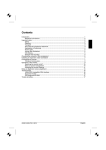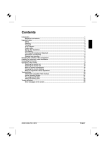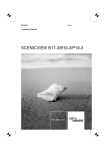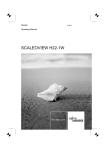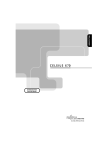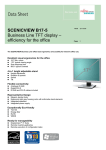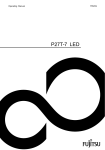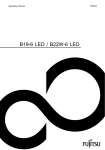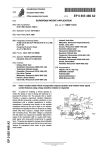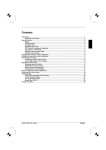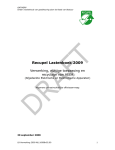Download Important notes
Transcript
Professional Monitor
English
Operating Manual
SCENICVIEW B17-5/B19-5
Are there ...
... any technical problems or other questions that you would like help with?
Please contact:
•
our Hotline/Help Desk (refer to the enclosed Help Desk List or go to:
"www.fujitsu-siemens.com/support/")
• your sales partner
• your sales office
The latest information on our products, tips, updates etc. can be found on
our website at: "www.fujitsu-siemens.com"
This manual was produced byXerox Global Services
Published by
Fujitsu Siemens Computers GmbH
AG04/08
Edition1
Order no.: A26361-K1255-Z120-1-7619
SCENICVIEW B17-5/B19-5
Operating Manual
Your LCD screen...
1
Important notes
3
Getting started
7
Operation
14
Troubleshooting
22
Notes regarding the DIN EN ISO
13406-2 standard
24
Technical data
25
VESA, DDC and DPMS are registered trademarks of Video Electronics Standards Association.
Copyright © Fujitsu Siemens Computers GmbH2008
All rights reserved, including in particular rights of translation, reproduction by printing,
copying or similar methods, in part or in whole.
Non-compliance is subject to compensation for damages.
All rights reserved, including rights created by patent grant or registration of a utility model or design.
Subject to availability and technical modifications.
No liability for content or printing errors.
Contents
Contents
Your LCD screen... . . . . . . . . . . . . . . . . . . . . . . . . . . . . . . . . . . . . . . . . . . . . . . . . . . . . . . . . . . . . . . . . . . . . .
Target group . . . . . . . . . . . . . . . . . . . . . . . . . . . . . . . . . . . . . . . . . . . . . . . . . . . . . . . . . . . . . . . . . . . . . . . . . . . .
Further information . . . . . . . . . . . . . . . . . . . . . . . . . . . . . . . . . . . . . . . . . . . . . . . . . . . . . . . . . . . . . . . . . . . . . .
Notational conventions . . . . . . . . . . . . . . . . . . . . . . . . . . . . . . . . . . . . . . . . . . . . . . . . . . . . . . . . . . . . . . . . . .
1
1
2
2
Important notes . . . . . . . . . . . . . . . . . . . . . . . . . . . . . . . . . . . . . . . . . . . . . . . . . . . . . . . . . . . . . . . . . . . . . . . .
Safety instructions . . . . . . . . . . . . . . . . . . . . . . . . . . . . . . . . . . . . . . . . . . . . . . . . . . . . . . . . . . . . . . . . . . . . . .
Power cable . . . . . . . . . . . . . . . . . . . . . . . . . . . . . . . . . . . . . . . . . . . . . . . . . . . . . . . . . . . . . . . . . . . . . . . . . . . .
Transporting the device . . . . . . . . . . . . . . . . . . . . . . . . . . . . . . . . . . . . . . . . . . . . . . . . . . . . . . . . . . . . . . . . . .
Cleaning the device . . . . . . . . . . . . . . . . . . . . . . . . . . . . . . . . . . . . . . . . . . . . . . . . . . . . . . . . . . . . . . . . . . . . .
CE marking . . . . . . . . . . . . . . . . . . . . . . . . . . . . . . . . . . . . . . . . . . . . . . . . . . . . . . . . . . . . . . . . . . . . . . . . . . . .
Energy Star . . . . . . . . . . . . . . . . . . . . . . . . . . . . . . . . . . . . . . . . . . . . . . . . . . . . . . . . . . . . . . . . . . . . . . . . . . . .
Disposal and recycling . . . . . . . . . . . . . . . . . . . . . . . . . . . . . . . . . . . . . . . . . . . . . . . . . . . . . . . . . . . . . . . . . .
3
3
4
4
4
5
5
6
Getting started . . . . . . . . . . . . . . . . . . . . . . . . . . . . . . . . . . . . . . . . . . . . . . . . . . . . . . . . . . . . . . . . . . . . . . . . .
Unpacking and checking the delivery . . . . . . . . . . . . . . . . . . . . . . . . . . . . . . . . . . . . . . . . . . . . . . . . . . . . .
Setting up the device . . . . . . . . . . . . . . . . . . . . . . . . . . . . . . . . . . . . . . . . . . . . . . . . . . . . . . . . . . . . . . . . . . . .
Setting up an ergonomic video workstation . . . . . . . . . . . . . . . . . . . . . . . . . . . . . . . . . . . . . . . . . . . .
Adjusting the height . . . . . . . . . . . . . . . . . . . . . . . . . . . . . . . . . . . . . . . . . . . . . . . . . . . . . . . . . . . . . . . . .
Adjusting the inclination . . . . . . . . . . . . . . . . . . . . . . . . . . . . . . . . . . . . . . . . . . . . . . . . . . . . . . . . . . . . . .
Adjusting the rotation . . . . . . . . . . . . . . . . . . . . . . . . . . . . . . . . . . . . . . . . . . . . . . . . . . . . . . . . . . . . . . . .
Adjusting portrait format . . . . . . . . . . . . . . . . . . . . . . . . . . . . . . . . . . . . . . . . . . . . . . . . . . . . . . . . . . . . .
Removing monitor base . . . . . . . . . . . . . . . . . . . . . . . . . . . . . . . . . . . . . . . . . . . . . . . . . . . . . . . . . . . . . .
Connecting the device . . . . . . . . . . . . . . . . . . . . . . . . . . . . . . . . . . . . . . . . . . . . . . . . . . . . . . . . . . . . . . . . . . .
Connecting cables to the monitor . . . . . . . . . . . . . . . . . . . . . . . . . . . . . . . . . . . . . . . . . . . . . . . . . . . . .
Connecting cables to the computer . . . . . . . . . . . . . . . . . . . . . . . . . . . . . . . . . . . . . . . . . . . . . . . . . . .
7
7
7
8
9
9
9
10
10
11
12
13
Operation . . . . . . . . . . . . . . . . . . . . . . . . . . . . . . . . . . . . . . . . . . . . . . . . . . . . . . . . . . . . . . . . . . . . . . . . . . . . . .
Switching the device on and off . . . . . . . . . . . . . . . . . . . . . . . . . . . . . . . . . . . . . . . . . . . . . . . . . . . . . . . . . .
Notes on power management . . . . . . . . . . . . . . . . . . . . . . . . . . . . . . . . . . . . . . . . . . . . . . . . . . . . . . . . . . . .
Changing the monitor settings . . . . . . . . . . . . . . . . . . . . . . . . . . . . . . . . . . . . . . . . . . . . . . . . . . . . . . . . . . . .
Changing the monitor settings with the buttons of the control panel . . . . . . . . . . . . . . . . . . . . . .
Changing the monitor settings using the OSD menu . . . . . . . . . . . . . . . . . . . . . . . . . . . . . . . . . . . .
14
14
15
15
16
17
Troubleshooting . . . . . . . . . . . . . . . . . . . . . . . . . . . . . . . . . . . . . . . . . . . . . . . . . . . . . . . . . . . . . . . . . . . . . . .
22
Notes regarding the DIN EN ISO 13406-2 standard . . . . . . . . . . . . . . . . . . . . . . . . . . . . . . . . . . . . . .
24
Technical data . . . . . . . . . . . . . . . . . . . . . . . . . . . . . . . . . . . . . . . . . . . . . . . . . . . . . . . . . . . . . . . . . . . . . . . . .
VESA-DDC-compatible VGA interface . . . . . . . . . . . . . . . . . . . . . . . . . . . . . . . . . . . . . . . . . . . . . . . . . . . .
Preset operating modes . . . . . . . . . . . . . . . . . . . . . . . . . . . . . . . . . . . . . . . . . . . . . . . . . . . . . . . . . . . . . . . . .
Most frequent operating modes . . . . . . . . . . . . . . . . . . . . . . . . . . . . . . . . . . . . . . . . . . . . . . . . . . . . . . .
SUB D port . . . . . . . . . . . . . . . . . . . . . . . . . . . . . . . . . . . . . . . . . . . . . . . . . . . . . . . . . . . . . . . . . . . . . . . . . . . . .
DVI-D port . . . . . . . . . . . . . . . . . . . . . . . . . . . . . . . . . . . . . . . . . . . . . . . . . . . . . . . . . . . . . . . . . . . . . . . . . . . . . .
25
26
26
27
27
28
A26361-K1255-Z120-1-7619, edition 1
Contents
A26361-K1255-Z120-1-7619, edition 1
Your LCD screen...
Your LCD screen...
has a whole range of useful features and functions, e.g.:
•
•
•
TFT display (Thin Film Transistor; active matrix)
minimal space requirements thanks to slim casing
optimum ergonomic characteristics (totally distortion-free, excellent picture
definition and colour purity right into the corners)
• high degree of brightness and good contrast
• high resolution (1280 x 1024)
• presentation of up to 16.7 million colours (in conjunction with an appropriate display adapter)
• automatic scanning of horizontal frequencies from 30 to 82 kHz and refresh rates
(vertical frequencies) from 56 to 75 Hz (absolutely flicker-free)
• digital screen controller with microprocessor for storing 28 different display modes
• freely adjustable colour alignment for matching the screen colours to the
colours of various input and output devices
• convenient operation via integrated OSD (On-Screen-display) menu
• VESA-DDC compatibility
• VESA-FPMPMI compatibility (Flat Panel Monitor Physical Mounting Interface) –
Mounting device for swivel arm and wall bracket
• Plug&Play capability
• power management for reducing power consumption when the computer is not in use
• Compliance with the recommendations according to TCO ’03
• the monitor fulfills all GS ("Geprüfte Sicherheit", Certified Security) requirements.
This operating manual contains important information you require to start up and run your LCD monitor.
A graphics card (display adapter) with VGA interface or a digital display adapter with
DVI interface is required to control the LCD monitor. The monitor processes the data
supplied to it by the display adapter. The display adapter or the associated driver software
is responsible for setting the modes (resolution and refresh rate).
When putting the monitor into operation for the first time, the screen display should be
optimally adapted to the display adapter used and adjusted in accordance with your
needs (see chapter "Changing the monitor settings", Page 15.
Target group
You don’t need to be an "expert" to perform the operations described here. However, please observe
the safety information given in the operating instructions for the computer and in this manual.
In the event of any problems occurring, please contact your sales outlet or our Help Desk.
A26361-K1255-Z120-1-7619, edition 1
1
Your LCD screen...
Further information
Details of how you set the resolution and refresh rate are provided in the documentation
for your display adapter and the associated driver software.
For ergonomic reasons, a screen resolution of 1280 x 1024 pixels is recommended.
Because of the technology used (active matrix) an LCD monitor provides a totally
flicker-free picture even with a refresh rate of 60 Hz.
Notational conventions
Pay particular attention to text marked with this symbol. Failure to observe
this warning will endanger your life, will damage the device or lead to loss
of data. The warranty will be invalidated if you cause defects in the device
through failure to take notice of this warning
indicates important information that is required to use the device properly.
►
indicates an activity that must be performed in the order shown
indicates a result
This style
flags data entered using the keyboard in a program dialog or command
line, e.g. your password (Name123) or a command to launch a program
(start.exe)
refers to information displayed by a program on the screen, e.g.:
Installation is completed
is for
"This style"
• terms and texts in a software user interface, e.g.: Click Save.
• names of programs or files, e.g. Windows or setup.exe.
is for
This style
This style
•
•
Abc
This style
2
cross-references to another section, e.g. "Safety information"
cross-references to an external source, e.g. a web address: For more
information, go to "www.fujitsu-siemens.com"
• indicates names of CDs and DVDs as well as names and titles of other
materials, e.g.: "CD/DVD Drivers & Utilities" or "Safety" manual
refers to a key on the keyboard, e.g.: F10
flags concepts and text that are emphasised or highlighted, e.g.: Do not
switch off device
A26361-K1255-Z120-1-7619, edition 1
Important notes
Important notes
Notes
Importantnotes
In this chapter you will find information regarding safety which it is essential to
take note of when working with your device.
Safety instructions
This device complies with the relevant safety regulations for data processing equipment,
including electronic office machines for use in an office environment. If you have any
questions, contact your sales outlet or our Help Desk.
•
•
•
•
•
•
•
•
•
•
•
•
•
•
•
•
•
•
The display surface of the device is sensitive to pressure and scratches. You should therefore
be careful with the display surface in order to avoid lasting damage (scratches).
If the device is brought into the installation site from a cold environment, condensation
can form. Before operating the device, wait until it is absolutely dry and has reached
approximately the same temperature as the installation site.
When installing and operating the device, please observe the notes on environmental
conditions in Chapter "Technical data", Page 25 as well as the instructions in Chapter
"Setting up an ergonomic video workstation", Page 8.
To ensure sufficient ventilation, the air inlet and outlet openings of the device must be kept clear.
The device automatically sets itself to the correct voltage within the range from 100 V to 240 V.
Make sure that the local mains voltage is neither higher nor lower than this range.
Ensure that the power socket on the device and the mains outlet are freely accessible.
The ON/OFF switch does not disconnect the monitor from the mains voltage. To disconnect
fully from the mains supply, disconnect the power plug from the socket.
The device is equipped with a power cable that complies with safety standards.
Use the supplied power cable only.
Lay the cables in such a way that they do not create a hazard (danger of tripping)
and cannot be damaged. When connecting the device, observe the relevant
notes in chapter "Connecting the device", Page 11.
No data transfer cables should be connected or disconnected during a thunderstorm.
Make sure that no objects (e.g. jewellery chains, paper clips, etc.) or liquids get
inside the device (danger of electric shock, short circuit).
The device is not waterproof! Never immerse the device in water and protect
it from spray water (rain, sea water).
In emergencies (e.g. damaged casing, elements or cables, penetration of
liquids or foreign matter), switch off the device, disconnect the power plug and
contact your sales outlet or our Help Desk.
Repairs to the device must only be performed by qualified technicians. Unauthorised opening
and incorrect repair may greatly endanger the user (electric shock, fire risk).
Only use the screen resolution settings and refresh rates specified in Chapter
"Technical data", Page 25. Otherwise you may damage the device. If you are in
any doubt, contact your sales outlet or our Help Desk.
Use a screen saver with moving images and activate the power management for
your monitor to prevent still images from "burning in".
If you operate the device with the swivel arm or wall bracket, it must not be turned by 180°.
A26361-K1255-Z120-1-7619, edition 1
3
Important notes
•
•
•
•
The device must only be operated in landscape mode (0°) and portrait mode (90°). The
control buttons are located in the middle of the bottom of the monitor in landscape mode
(0°) and at the left-hand side of the monitor in portrait mode (90°).
Store this manual close to the device. If you pass the device on to third
parties, you should pass this manual on with it.
We recommend that you place your device on a durable, non-slip surface. In view
of the many different finishes and varnishes used on furniture, it is possible that the
feet of the device may mark the surface they stand on.
To ensure sufficient ventilation, the air supply and air outlet openings of
the monitor must never be blocked.
Power cable
Use the supplied power cable only.
Use the following guidelines if it is necessary to replace the original cable set.
•
•
•
•
•
The female/male receptacles of the cord set must meet IEC60320/CEE-22 requirements.
The cable has to be HAR-certified or VDE-certified. The mark HAR or
VDE will appear on the outer sheath.
For devices which are mounted on a desk or table, type SVT or SJT cable sets may be
used. For devices which sit on the floor, only SJT type cable sets may be used.
The cable set must be selected according to the rated current for your device.
If necessary, replace the original power cable with a regular grounded 3-core mains lead.
Transporting the device
Retransportation
Transportation
Device,
Transport all parts separately in their original packaging or in a packaging which
protects them from knocks and jolts, to the new site.
Do not unpack them until all transportation manoeuvres are completed.
Cleaning the device
Switch off the device and unplug the power plug.
Do not clean any interior parts yourself, leave this job to a service technician.
Do not use any cleaning agents that contain abrasives or may corrode plastic.
Ensure that no liquid enters the device.
The display surface of the device is sensitive to pressure and scratches. Clean
it only using a soft, slightly moistened cloth.
The surface of the casing can be cleaned with a dry cloth. If particularly dirty, use a cloth that
has been moistened in mild domestic detergent and then carefully wrung out.
4
A26361-K1255-Z120-1-7619, edition 1
Important notes
CE marking
The shipped version of this device complies with the requirements of EEC
directives 2004/108/EC "Electromagnetic compatibility" and 2006/95/EC
"Low voltage directive".
Energy Star
EnergyStar
The Fujitsu Siemens LCD colour monitor is equipped with
a power management system which reduces the power
draw in OFF mode to less than 1 W. With this new power
management the LCD monitor satisfies the requirements for
the U.S. Environmental Protection Agency’s (EPA) Energy Star
Computers award.
The EPA estimates that computer equipment uses 5 % percent of all business electricity
and that this is growing rapidly. If all desktop PCs and peripherals enter a low-power mode
when not in use, the overall savings in electricity could amount to $2 billion annually.
These savings could also prevent the emission of 20 million tons of carbon dioxide into
the atmosphere - the equivalent of 5 million automobiles.
As an Energy Star Partner, Fujitsu Siemens Computers GmbH has determined that this
product meets the Energy Star guidelines for energy efficiency.
A26361-K1255-Z120-1-7619, edition 1
5
Important notes
Disposal and recycling
This device has been manufactured to the highest possible degree from materials which
can be recycled or disposed of in a manner that is not environmentally damaging. The
device may be taken back after use to be recycled, provided that it is returned in a
condition that is the result of normal use. Any components which cannot be recycled
will be disposed of in an environmentally acceptable manner.
The device must be disposed of in accordance with the local regulations for disposal of
special waste. The screen background lighting contains mercury. You must observe the
applicable handling and disposal safety regulations for fluorescent tubes.
If you have any questions on disposal, please contact your local office, our Help Desk, or:
Germany
Fujitsu Siemens
Computers GmbH
Remarketing and Recycling
D-33106 Paderborn
Tel.: +49 5251 / 81 80 10
Fax: +49 5251 / 81 80 15
"http://www.fujitsu-siemens.de
/wvm"
Asia
Taiwan: Environmental
Protection
Administration
Executive Yuan R.O.C.
"http://recycle.epa.gov.tw"
Belgium
Switzerland
SWICO Swiss Association for
Information, Communications
and Organization Technology
For a list of SWICO
collection points, see:
"http://www.swico.ch".
RECUPEL Boulevard
Reyers, 80
B-1030 Brussels
Tel.: +32 2 / 706 86 16
Fax: +32 2 / 706 86 13
E-mail: [email protected]
"http://www.recupel.be"
USA
Fujitsu Siemens Computers Inc.
1250E. Arques
Avenue Sunnyvale,
CA 94085 U.S.A.
Contact: Schroettle-Henning,
Bernd
Phone No.: (408) 834-0306
Fax No.: (408) 746-8299
For more information on this subject, please go to "www.fujitsu-siemens.com/recycling".
6
A26361-K1255-Z120-1-7619, edition 1
Getting started
Getting started
Unpacking and checking the delivery
The display surface of the device is sensitive to pressure and scratches.
Always hold the device by the casing!
The complete device package includes:
•
•
•
•
•
•
•
•
one
one
one
one
one
one
one
one
monitor
data cable (D-SUB)
data cable (DVI-D)
audio cable
power cable
CD with software and documentation
Warranty Booklet
"Safety" manual
►
►
►
►
Unpack all the individual parts.
Check the contents of the package for any visible damage caused during transport.
Check whether the delivery conforms to the details in the delivery note.
Should you discover that the delivery does not correspond to the delivery
note, notify your local sales outlet immediately.
Do not discard the original packing material of the devices. You may need the
packaging in the future if you need to transport your device.
Setting up the device
To ensure sufficient ventilation, the air inlet and outlet openings of
the device must be kept clear.
A26361-K1255-Z120-1-7619, edition 1
7
Getting started
Setting up an ergonomic video workstation
► Do not position the video workstation
opposite a window (1).
1
1
► Position the monitor outside the reach
of a light source (1).
► Position the keyboard where it is
easiest to reach (1).
1
8
A26361-K1255-Z120-1-7619, edition 1
Getting started
► Position the monitor so that the eye distance
to the screen (1) is around 50 cm.
1
50 cm
1
0
65
► Position the monitor for optimum viewing
(1). The monitor should under no
circumstances fall outside the permissible
viewing space (2).
30
60
30
65
2
2
Depending on the situation, it may be advisable to use a swivel arm or wall
bracket (VESA FPMPMI), which are available from specialist dealers. For
this purpose the monitor base must be removed beforehand as described
in Chapter "Removing monitor base", Page 10.
Adjusting the height
The height of the monitor can be adjusted by approximately 120 mm.
► Grasp the monitor with both hands on the right and left edge of the casing
and move it upward or downward.
Adjusting the inclination
► Hold the monitor with both hands on the left and right sides of the casing
and move it to the desired angle.
Adjusting the rotation
The monitor can be horizontally rotated by ± 45° from its centre position.
► Grasp the monitor with both hands on the right and left edge of the casing
and turn it to the desired position.
A26361-K1255-Z120-1-7619, edition 1
9
Getting started
Adjusting portrait format
The monitor can be rotated from horizontal format (landscape mode) into
vertical format (portrait mode).
► Grasp the monitor with both hands on the right and left edge of the casing, move it into
the highest position and turn it clockwise until it is in the portrait position.
For you to be able to display the screen contents in portrait mode, your graphics card
will also need to support this function or you will need to use special software.
In the OSD menu you have the option of switching the OSD manually
from landscape mode to portrait mode (see "Changing the monitor
settings using the OSD menu", Page 17).
To reset the monitor to landscape mode, the monitor should be turned anti-clockwise.
The OSD display can be reset again in the OSD menu.
Removing monitor base
Before you can use a swivel arm or a wall bracket, you must remove the monitor base.
The display surface is susceptible to scratching!
► Switch off the monitor and pull the power
plug out of the power socket.
► Lay the monitor on its face on a soft surface.
► Remove all cables.
► To remove the monitor base, undo the
screws on the monitor base.
You can now mount a swivel arm or a wall
bracket in accordance with VESA FPMPMI
using a hole spacing of 100 mm.
For instructions on how to mount the
swivel arm or wall bracket, please
see the documentation for the swivel
arm or wall bracket.
Please observe the safety information in "Important notes", Page 3.
For instructions on how to mount the swivel arm or wall bracket, please see
the documentation for the swivel arm or wall bracket.
10
A26361-K1255-Z120-1-7619, edition 1
Getting started
Connecting the device
Please observe the safety information in "Important notes", Page 3.
CE conformance and optimum picture quality are guaranteed only if
you use the data cables supplied.
► Switch off the monitor and the computer.
► Disconnect the power plug from the computer.
A26361-K1255-Z120-1-7619, edition 1
11
Getting started
Connecting cables to the monitor
The monitor ports are protected by a cover.
The supplied data cables have two 15-pin D-SUB connectors or two 24-pin DVI
connectors for connection to the monitor and to the computer.
Information on the computer connections and interfaces is contained in the
operating manual for the computer.
► Remove the cover (2).
► Select the appropriate data cable for your computer.
2
1
4
5
3
1 = Mains socket
2 = Security slot for the "Kensington Lock"
3 = D-SUB socket (ANALOG)
4 = AUDIO-IN socket
5 = DVI-D connector (DIGITAL)
► Connect one of the connectors of the data cable to the D-SUB connector (3) or the DVI-D
connector (4) on the monitor and secure the plug-in connection by tightening the retaining screws.
► Insert one connector of the audio cable in the AUDIO IN (5) socket on the
monitor and make sure it is properly engaged.
► Connect the supplied mains cable into the power socket (1) of the monitor.
A lock (Kensington Lock) can be mounted in the security slot to protect the monitor
against theft. A Kensington lock is not supplied with the monitor.
12
A26361-K1255-Z120-1-7619, edition 1
Getting started
Connecting cables to the computer
Information on the computer connections and interfaces is contained in the
operating manual for your computer.
► Connect the data cable to the (active) monitor port on the computer and secure
the plug-in connection by tightening the safety screws.
► Insert the other plug of the audio cable in the audio output of the computer.
► Plug the power connector of the monitor into a properly grounded mains outlet.
► Plug the power connector of the computer into a properly grounded mains outlet.
If your computer has two monitor ports ("onboard" screen controller and separate
graphics card), the monitor port for the separate graphics card is active as standard.
A26361-K1255-Z120-1-7619, edition 1
13
Operation
Operation
Switching the device on and off
The ON/OFF switch on the front of the monitor is used for switching the monitor on and off.
Press the buttons from the bottom up.
1
2 3
1 = Buttons for the OSD menu (On-Screen
Display)
2 = Power indicator
3 = ON/OFF switch
► First switch on the LCD monitor with the ON/OFF switch (3).
► Then switch on the computer.
Only switch the computer on once you have switched the monitor on.
14
A26361-K1255-Z120-1-7619, edition 1
Operation
Notes on power management
If your computer is equipped with power management, the monitor can support this function
fully. The monitor does not distinguish between the individual power management modes of
the computer (standby mode, suspend mode and OFF mode), as it is capable of immediately
switching into the mode with the highest energy-saving effect.
Stage
Power indicator
Function
Power consumption (typical)
ON
Power management mode
lights up blue
lights up orange
the monitor is working normally the screen is dark
Normal
reduced to < 1 W
< 32 W typical (17")
< 37 W typical (19")
If your computer detects inactivity (no input) it sends an appropriate signal to the monitor
to reduce the power consumption (power management mode). The power indicator of
the monitor changes colour to indicate the status change.
Once an input is made at the computer the screen contents are redrawn.
For detailed information on how power management mode operates refer to
the operating manual or technical manual of the computer.
When the monitor is switched to the power management mode by the power
management system a power consumption of up to 1 W is maintained to
feed the circuit for redrawing the screen contents.
To completely switch off the power consumption, switch off the monitor
with the main switch at the rear.
Changing the monitor settings
When putting the monitor into operation for the first time, the screen display should
be optimally adapted to the display adapter used.
A26361-K1255-Z120-1-7619, edition 1
15
Operation
Changing the monitor settings with the buttons
of the control panel
The buttons of the control panel have two functions. With the OSD menu not
activated, you can make the following settings directly:
INPUT
SELECT/ MENU
EXIT / AUTO
1
1 = Buttons for the OSD menu (On-Screen
Display)
2 = Power indicator
2
3
3 = ON/OFF switch
Performing auto-adjustment of the monitor
► Press the EXIT / AUTO button for about 1 second.
The Auto Processing message appears
Picture quality and position are set to optimum values for your system.
Selecting the input signal (D-SUB/DVI_D)
► Press the Back / INPUT button to open the Input select setting window.
► Press the Forward / Mute button or the Back / INPUT button to select the desired
monitor connection (analog D-SUB or digital DVI-D).
This setting window can also be called when the OSD menu is locked.
Activating/deactivating muting
► Press the Mute button to switch the sound off and on again.
The Action was executed message appears.
16
A26361-K1255-Z120-1-7619, edition 1
Operation
Locking the OSD menu
The OSD menu can be locked to prevent accidental or unauthorised changes to the monitor settings.
► Press and hold the SELECT/MENU button for a few seconds while you switch
on the monitor with the ON/OFF switch.
The Action was executed message appears.
Please proceed in the same manner to release the locked OSD menu again.
Locking the ON/OFF button
The ON/OFF switch can be locked to prevent accidental or unauthorised
changes to the monitor settings.
► Press and hold the Forwards / Mute button and the Back / INPUT button
at the same time for a few seconds.
The Action was executed message appears.
Please proceed in the same manner to release the locked ON/OFF switch again.
Changing the monitor settings using the OSD menu
With the buttons on the control panel, call up and use the integrated OSD (On-Screen display) menu.
The OSD menu is available in different languages. The English menu names
are used in the following description (default setting). You can select a different
language using the Language OSD function in the OSD Setup.
► Press the SELECT / MENU button to
activate the OSD menu.
The main menu appears with icons
for the setting functions.
The first icon (Brightness/Contrast) is
highlighted and the associated functions are
displayed in the right-hand menu field.
A26361-K1255-Z120-1-7619, edition 1
17
Operation
► Press the Forwards / Mute button or
the Back / INPUT button to highlight a
different icon (e.g. Image adjust).
► Press the SELECT / MENU button to
select the highlighted icon.
The Image adjust setting window is displayed.
The first function H-position is selected.
► Press the Forwards / Mute button or
the Back / INPUT button to highlight
a different function.
► Press the SELECT / MENU button to
select the highlighted function.
► Press the Forwards / Mute button or
the Back / INPUT button to highlight
a different function.
► Press the EXIT / AUTO button to
exit the function.
► Press the Forwards / Mute button or the
Back / INPUT button to highlight a different
function or press the EXIT / AUTO button
to return to the main menu.
All changes are stored automatically.
If you want to change other settings, select the corresponding function from the OSD
main menu. All possible adjustments of the main menu are described in the following.
OSD menu functions
The OSD menu for analog monitor operation is described below. During
digital operation some functions are not available, as they are not required
due to the digital transmission technology used.
18
A26361-K1255-Z120-1-7619, edition 1
Operation
Adjusting the brightness and contrast
Call up the Brightness/Contrast setting window
Brightness
Set the brightness of the display
Contrast
With this function you change the brightness of the background lighting.
Set the contrast of the display
With this function you modify the contrast of bright colour tones.
Black level
Set the brightness of the display
Auto level
With this function you modify the contrast of dark colour tones.
Adjust the signal level
With this function you can automatically set the contrast.
The function is executed with the SELECT / MENU button.
If the contrast is set too high, bright surfaces can no longer be distinguished from very
bright surfaces. If the contrast is set too low, the maximum brightness will not be achieved.
Adjusting the picture size and position
Call the Image adjust setting window
Phase
Eliminate picture disturbance
With this function you fine-tune your monitor to eliminate picture disturbance.
Clock
Set synchronisation
H-Position
With this function you adjust the picture width to eliminate vertical picture
disturbances.
Adjust the horizontal position
V-Position
With this function you move the picture to the left or to the right.
Adjust the vertical position
With this function you move the picture up or down.
Adjusting the volume
Call the Audio setting window
Volume
Mute
Set the volume for playback with the integrated loudspeakers
Switch the loudspeakers off or on
A26361-K1255-Z120-1-7619, edition 1
19
Operation
Setting colour temperature and colours
Call the Colour setting window
Select the colour temperature
The "warmth" of the screen colours is set using the colour temperature. The
colour temperature is measured in K (= Kelvin). You can choose between
sRGB, 6500 K, 9300 K, Native and Custom Colour.
The options sRGB, Native and Custom colour are only available in the Office
setting mode.
In the user-defined setting you can change the colour ratios of the basic
colours (red, green, blue) as required.
Adjusting the display of the OSD menu
Calling the OSD Setup adjustment window
Language
Selecting the language for the OSD menu
OSDH position
With this function you choose between English (default setting), French,
German, Italian and Spanish as the language for the OSD menu.
Setting the horizontal position of the OSD menu
OSDV position
With this function you can move the OSD menu to the left or to the right.
Setting the vertical position of the OSD menu
OSDTimeout
With this function you can move the OSD menu up or down.
Setting the display duration of the OSD menu
With this function you can select a value from 10 to 120 seconds.
OSD Rotation
If the set time expires without a setting being made, the OSD menu is
automatically hidden.
With this function you switch the OSD menu from portrait mode to landscape
mode and vice versa.
Off = The OSD menu is displayed in portrait mode.
On = The OSD menu is displayed in landscape mode.
20
A26361-K1255-Z120-1-7619, edition 1
Operation
Adjusting the functions in the Advanced menu
Calling up the Advanced window
Input select
Selecting the input signal
This function allows you to switch the monitor from analog to digital mode
and vice versa when two signal sources are connected,
provided the graphics card supports this function.
DDC-CI
Activate/deactivate the DDC-CI function
On = DDC-CI function is activated (default setting)
ResolutionNotifier
Off = DDC-CI function is deactivated
Displaying screen information
The optimum resolution for this monitor is 1280 x 1024 pixels. With the
function activated (On), a message appears on the screen after approx. 30
seconds if a different resolution is set.
Change the resolution to 1280 x 1024 to achieve optimum picture quality.
Factory Recall
With the function deactivated (Off), no message appears.
Activates the factory settings
This function is used to reset all settings to the factory settings. The user is
not prompted to confirm the changes.
Press the SELECT/MENU button to execute this function. The message
Auto Processing is displayed.
Displaying information
Call the Information setting window
With this function the model designation, serial number, resolution, H/V
frequency, input signal and polarity of the synchronisation signal are
displayed.
A26361-K1255-Z120-1-7619, edition 1
21
Troubleshooting
Troubleshooting
Should an error occur, first check the following points. If the distortion is still not eliminated,
the monitor should, if possible, be checked on another computer.
If you are unable to solve the problem, please inform our help desk.
Having this problem?
No screen display
Power indicator does not light up
No screen display
Power indicator is lit
Message: No Signal
Check the following points:
► Check whether the main switch at the rear
of the monitor is switched on.
► Check whether the power cable on the
monitor is connected correctly.
► Check whether the computer is switched on.
► Check whether the computer is switched on.
► Check whether the data cable for the
monitor is correctly attached to the monitor
port on the computer.
► Press any key on the computer keyboard.
The computer may be in power saving
mode.
► Alter the brightness and/or contrast until you
get a picture.
► Check whether the data cable for the
monitor is correctly attached to the monitor
port on the computer.
► Check whether the computer is switched on.
The input signal (horizontal frequency and
refresh rate) at the displayed input does not
correspond to the technical data for the monitor.
► Adjust the video frequency range using the
computer software (see documentation for
the computer or display adapter).
► Set a different screen resolution using the
computer software (see documentation for
the computer or display adapter).
Picture position not correct
Picture is shaking
Picture is wrongly adjusted
22
The monitor recognises an undefined mode (see
chapter "Technical data", Page 25).
► Press the EXIT / AUTO button to perform
auto-adjustment of the screen.
► Check whether the data cable for the
monitor is correctly attached to the monitor
port on the computer.
► Press the EXIT / AUTO button to perform
auto-adjustment of the screen.
► Press the SELECT / MENU button to
activate the Factory Recall function.
The Auto Processing message appears.
A26361-K1255-Z120-1-7619, edition 1
Troubleshooting
Having this problem?
Check the following points:
Picture disturbances (vertical lines)
► Press the EXIT / AUTO button to perform
auto-adjustment of the screen.
► Press the EXIT / AUTO button to perform
auto-adjustment of the screen.
The background lighting has a limited lifetime.
If your monitor display should become too dark,
the background lighting will have to be replaced.
Picture disturbances (horizontal lines, picture
noise)
The screen becomes darker
► Please contact our help desk.
A26361-K1255-Z120-1-7619, edition 1
23
Notes regarding the DIN EN ISO 13406-2 standard
Notes regarding the DIN EN ISO
13406-2 standard
Permanently unlit or lit pixels
The standard of production techniques today cannot guarantee an absolutely fault-free screen
display. A few isolated constant lit or unlit pixels (picture elements) may be present. The maximum
permitted number of pixels faults is stipulated in the international standard ISO 13406-2 (Class II).
Examples:
Example: A 17"/19” flat-screen monitor with a resolution of 1280 x 1024 has 1280 x 1024 =
1310720 pixels. Each pixel consists of three subpixels (red, green and blue), so
there are almost 4 million dots in total. In accordance with ISO 13406-2 (Class II), a
maximum of 6 pixels and also 7 subpixels may be faulty
24
A26361-K1255-Z120-1-7619, edition 1
Technical data
Technical data
Condensation is not permissible either in the rated range of operation
or in the limit range of operation.
Dimensions and weight
Visible diagonal
Dot pitch
Image size
Width
Height
Maximum resolution
Dimensions incl.
Width
monitor base
Height
Depth
Width
Dimensions of box
Height
Depth
Weight (without packaging)
Storable display modes
Pixel error classes
Class
according to ISO
13406-2
Accessories
B17-5
B19-5
43 cm
0.264 mm
337.9 mm
270.3 mm
1280 x 1024
373 mm
405 mm
209 mm
453 mm
436 mm
212 mm
approx. 5.1 kg
25
II
48 cm
0.294 mm
376.3 mm
301 mm
1280 x 1024
412 mm
409 mm
209 mm
453 mm
464 mm
212 mm
approx. 5.45kg
25
II
Power cable (1.8 m)
D-SUB data cable (1.8 m)
DVI-D data cable (1.8 m)
Audio cable (1.8 m)
Electrical data
Video
Analogue
Digital
Synchronisation
Horizontal frequency
refresh rate
Maximum pixel rate
Power supply
A26361-K1255-Z120-1-7619, edition 1
Positive, 0.7 Vss, 75 Ω
DVI-D with HDCP
Separate Sync. TTL,
positive or negative
30 kHz .... 82 kHz
(multi-scanning)
56 Hz .... 75 Hz
135 MHz
switches automatically,
100 V – 240 V, 50 Hz
– 60 Hz
25
Technical data
Overall power draw
Normal operation
< 32 W in normal mode
(17")
Sound output
< 37 W in normal mode
(19")
< 1 W in power saving
mode
1.0 W left; 1.0 W right
Ambient conditions
Environment class 3K2, IEC 721
Rated range of operation
15 °C .... 35 °C
Humidity
Limit range of operation
20 % .... 85 %
5 °C .... 35 °C
Humidity
20 % .... 85 %
Power saving mode
VESA-DDC-compatible VGA interface
Your monitor is equipped with a VESA-DDC-compatible VGA interface. VESA-DDC (Video
Electronics Standard Association, Display Data Channel) is used as the communications
interface between the monitor and the computer. If the computer is equipped with a
VESA-DDC-compatible VGA interface, it can automatically read the data for ensuring
optimum operation from the monitor and select the appropriate settings.
Preset operating modes
The picture position and size have been optimised at the factory for the operating
modes listed above. Depending on the graphics card used, it may be necessary
to adjust the display position or size. In this case you can change and save the
settings (see chapter "Changing the monitor settings", Page 15).
26
A26361-K1255-Z120-1-7619, edition 1
Technical data
Most frequent operating modes
Horizontal frequency
31.5 kHz
31.5 kHz
37.5 kHz
37.9 kHz
46.9 kHz
48.4 kHz
60.0 kHz
64.0 kHz
79.9 kHz
Refresh rate
70 Hz
60 Hz
75 Hz
60 Hz
75 Hz
60 Hz
75 Hz
60 Hz
75 Hz
Screen resolution
720 x 400
640 x 480
640 x 480
800 x 600
800 x 600
1024 x 768
1024 x 768
1280 x 1024
1280 x 1024
For ergonomic reasons, a screen resolution of 1280 x 1024 pixels is recommended.
Because of the technology used (active matrix) an LCD monitor provides a totally
flicker-free picture even with a refresh rate of 60 Hz.
SUB D port
5
1
10
6
15
Pin
1
2
3
4
5
6
7
8
9
10
11
12
13
14
15
11
Meaning
Video input red
Video input green
Video input blue
Ground
Ground
Video ground red
Video ground green
Video ground blue
+5 V (DDC)
Sync. ground
Ground
DDC Data
H. sync
V. sync
DDC Clock
A26361-K1255-Z120-1-7619, edition 1
27
Technical data
DVI-D port
1
9
17
Pin
1
2
3
4
5
6
7
8
9
10
11
12
13
14
15
16
17
18
19
20
21
22
23
24
28
Meaning
TMDS Data2–
TMDS Data2+
TMDS Data 2/4 Shield
not connected
not connected
DDC Clock
DDC Data
Analog Vertical Sync
TMDS Data1–
TMDS Data1+
TMDS Data 1/3 Shield
not connected
not connected
+5V Power
Ground
Hot Plug Detect
TMDS Data0–
TMDS Data0+
TMDS Data 0/5 Shield
not connected
not connected
TMDS Clock Shield
TMDS Clock+
TMDS Clock–
A26361-K1255-Z120-1-7619, edition 1




































